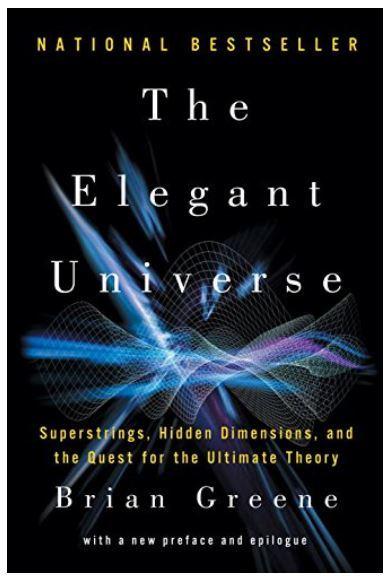
Do you remember the movie “A Beautiful Mind” from a few years ago? Russell Crow played John Nash, a highly intelligent person who could almost see mathematical formulae as he looked at the world. Well – in his book The Elegant Universe, Brian Greene has laid out the fascinating ideas behind String Theory and its bigger cousin M-Theory. He’s no John Nash – he’s fun and engaging. He explains complex ideas in such a compelling and interesting way! This sure isn’t a dull and boring physics book. It is a joy to read, and only gets tough to chew on in the latter portions of the book.
Greene starts with Einstein and the Special Theory of Relativity. Light speed is constant (Han Solo did know that…it was his navi-computer that made the Falcon fast), and space and time are interwoven, motion is relative between observer and observed. Even more bizarrely, as we speed up, our clock ticks slower from the perspective of a stationary observer. The General Theory of Relativity builds on this and Newton’s law of gravity. Now, Greene points out that Newton only described what gravity did. Einstein’s genius is that he manged to work out how it may work! Mass warps space. Imagine a bowling ball placed on a rubber sheet pulled tight. The sheet dips around the ball, right? Well that is kinda what mass does to space and time. So when planets move into the vicinity, their motion is affected, as they dip into the valley, they orbit the bowling ball. The sun. Greene explains all these mind expanding ideas in such an accessible way.
Well – what about the small stuff? What happens when we look at the universe really closely? Well – weirdness abounds and Greene describes all this in an interesting way. Quantum Mechanics describes the probabilistic nature of electrons, protons and neutrons. You cant predict exactly where these tiny particles will be – they are unpredictable and – tend to suddenly tunnel from one side to another unexpectedly. Weird! Greene points out that its worse than weird. Relativity is incompatible with Quantum Mechanics. So – what are physicists going to do? They don’t like it when their two best theories contradict each other.
Enter Superstring Theory! Spoiler alert – but the theory is named that way because it proposes that elemental particles in nature (electrons, etc) aren’t particles at all. Rather, they are tiny one dimensional strings vibrating at different frequencies. The thing is – when physicists view nature this way, they seem to be able to understand and predict what nature will do. From black holes to the big bang – String Theory is very descriptive of nature.
But – there’s a problem. There seems to be no experimental way to prove String Theory. Further, they don’t really understand the equations that define it, and it seems to need 6 additional spatial dimensions. Yikes. Now, Greene is most comfortable when he tells you how wonderful the theory is. He is less confident pointing out the fast that – unfortunately – its just a theory and has not been evidentially confirmed…yet. Greene’s book came out 15 years ago or so…before the CERN Large Hadron Collider LHC particle accelerator was switched on. It’s the biggest in the world. He had high hopes it would prove String Theory. I’m not sure the Higgs Boson has verified Superstring theory.
Greene’s brilliant description of all these things – leaves me with some questions.
1. Is it Provable?
Einstein’s theories are beautifully supported by evidence from nature. So, we would expect any additional theory to have evidence too. The problem is the strings themselves are so small, they are not directly detectable. Greene observes that we would need a particle accelerator “the size of the galaxy to see individual strings,”[1] which are “17 orders of magnitude smaller than we can currently access.”[2] We aren’t going to directly prove Superstring Theory any time soon.
2. Is It Science?
Greene admits that only approximations to the ST equations are known, and even those have not been fully solved.[3] Also, the theory did not come from a scientific inference to the best explanation of a natural observation. Rather, a two hundred year old mathematical formula was accidently found to describe the interactions between particles. When the particles were replaced with the idea of tiny vibrating strings, nuclear force was also described. This seems like serendipity combined with creativity rather than rigorous and methodical scientific method?
3. Might it Point to God?
Are Superstring physicists guided by the beauty of the theory more than its scientific merit, and does this have theistic implications? Greene concedes the math is so complex that approximations are substituted. Couple this with a lack of experimental confirmation, and it seems they are driven by a theory with “elegance and beauty of structure on par with the world we experience.”[4]
But doesn’t our expectation of beauty in nature, and our experience of and appreciation of natural beauty, challenge a purely naturalistic understanding to nature? How odd that a purely natural, randomly formed system with no guiding intelligence has formed beings who love to find beauty in the randomly formed universe they inhabit?
I wonder whether the scope of science and our love of the beautiful point to the activity of a divine creator?
[1] Brian Greene, The Elegant Universe Superstrings, Hidden dimensions, and the Quest for the Ultimate Theory, (London: W. W. Norton & Company, 2003), 215.
[2] Ibid
[3] Greene, 19.
[4] Greene, 167.
